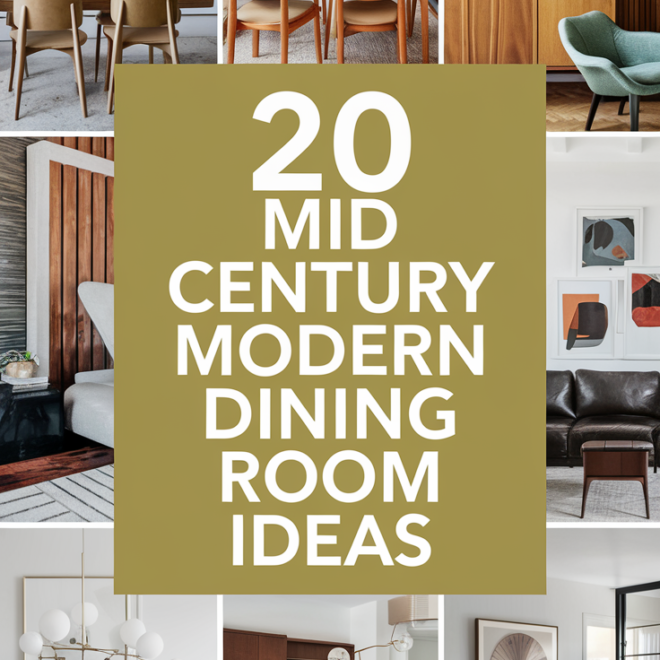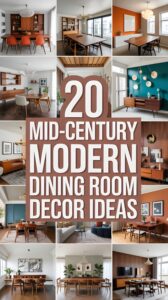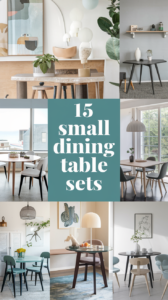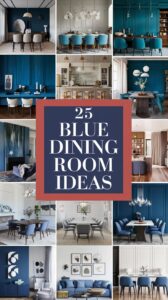Okay, let’s shift gears from dodgy dates and housewarming panic buys to the eternally cool, sometimes frustratingly ubiquitous world of Mid-Century Modern. You want that clean, sophisticated dining space where you can imagine Don Draper nursing an Old Fashioned (minus the existential dread, hopefully). It’s a look, alright. And like any popular look, it can easily slide into cliché if you’re not careful.
So, you’re aiming for that blend of organic shapes, clean lines, and maybe a dash of atomic-era optimism in your dining room. Not just a slavish copy from a catalogue, but something with a bit of personality. Here are 20 ideas to get you started, mixing the iconic with the practical, because even stylish people need to actually eat dinner.
1. The Iconic Table: Walnut & Clean Lines
Let’s start with the centerpiece. Think sleek, often rectangular or subtly boat-shaped tables, usually in warm wood tones like walnut or teak. Tapered legs are practically mandatory. It’s simple, it’s functional, it doesn’t shout, but it definitely sets the tone.
[Image: A classic walnut dining table with elegant tapered legs, maybe a simple runner down the middle.]
2. Eames Molded Chairs: The Obvious Choice (for a reason)
Yeah, they’re everywhere. But the Eames Molded Plastic or Fiberglass chairs (with dowel legs, Eiffel tower base, whatever) are popular because they work. They’re sculptural, surprisingly comfy, and add instant MCM cred. Mix colours or keep it uniform. Just accept you’ll see them in every third cafe you visit.
[Image: A dining table surrounded by several Eames Molded Plastic chairs, perhaps in white or a mix of muted colours.]
3. Wishbone Chairs: Scandinavian Elegance
Hans Wegner’s Wishbone chair brings a softer, more organic, slightly Scandinavian touch. That curved backrest and woven seat are iconic. They’re pricier, even the decent replicas, but damn, they look good. A statement piece that’s also a chair.
[Image: Two Wishbone chairs positioned at the heads of a dining table, showcasing their distinctive Y-shaped backs.]
4. A Statement Pendant Light: The Sputnik or Artichoke
Lighting is crucial. Hang a bold pendant light low over the table. Think Sputnik chandeliers with their bursting arms, or something more sculptural like an Artichoke lamp (if your budget stretches that far). It’s functional art.
[Image: A dramatic Sputnik chandelier hanging above a mid-century dining table.]
5. Bold Geometric Rug: Anchor the Space
Ground the dining set with a rug featuring a bold geometric pattern or a strong, abstract design. Think oranges, teals, mustards, or graphic black and white. It adds warmth and visual interest without overwhelming the clean lines.
[Image: A dining set placed on a rug with a distinctive mid-century geometric pattern.]
6. Teak Sideboard/Credenza: Storage with Style
You need somewhere to stash the good plates and random clutter. A long, low teak or walnut sideboard is quintessential MCM. Look for sliding doors, minimalist hardware, and those signature tapered legs. Plus, it’s a great surface for a lamp or a record player.
[Image: A vintage-style teak credenza against a wall near the dining area, possibly topped with a lamp and some decorative objects.]
7. Bar Cart: Ready for Cocktails
Nothing says mid-century entertaining like a well-stocked bar cart. Find one in brass, chrome, or wood, load it up with some nice glassware and decent bottles. It adds a touch of glamour and encourages impromptu Manhattans.
[Image: A stylish rolling bar cart with bottles, glassware, and cocktail tools, positioned in a corner of the dining room.]
8. Abstract Wall Art: Colour and Form
Bare walls are boring. Hang some abstract art – think bold colours, simple forms, maybe screen prints or canvases inspired by the era. It doesn’t have to be expensive, just something that catches the eye and complements the furniture.
[Image: A large, colourful abstract painting hanging on the wall above the sideboard.]
9. Incorporate Houseplants: Organic Touch
Like we said with housewarming gifts, greenery softens the edges. A tall fiddle-leaf fig in a corner, some smaller succulents on the sideboard – plants add life and that organic element crucial to MCM design. Just try not to kill them.
[Image: A large potted plant like a Monstera or Fiddle Leaf Fig standing in a corner of the dining room.]
10. Mix Chair Styles (Carefully)
If matching Eames chairs feels too predictable, try mixing it up. Combine molded plastic side chairs with upholstered chairs at the ends, or pair a bench on one side with chairs on the other. Keep the scale and wood tones consistent to avoid chaos.
[Image: A dining table with two different but complementary styles of MCM chairs, perhaps Eames side chairs and upholstered armchairs.]
11. Pops of Period-Appropriate Colour
While wood is dominant, MCM isn’t afraid of colour. Think accents of teal, mustard yellow, olive green, or burnt orange. Use it in upholstery, artwork, textiles, or even a single painted accent wall (if you’re brave).
[Image: A dining room with neutral furniture but with colourful accents like mustard yellow seat cushions or teal wall art.]
12. Minimalist Table Setting: Less is More
Keep the tabletop relatively uncluttered. Simple placemats (or none), clean-lined dinnerware, maybe a single low floral arrangement or a sculptural object. Let the furniture do the talking.
[Image: A dining table set with simple, modern plates, flatware, and perhaps linen napkins, looking clean and uncluttered.]
13. Mirror Magic: Create Space and Light
A large mirror, especially one with a unique shape (starburst, rounded edges) or a simple wood frame, can make the room feel bigger and brighter. Plus, it lets you subtly check if you have food in your teeth.
[Image: A stylish sunburst mirror hanging on the dining room wall.]
14. Exposed Wood Grain: Celebrate the Material
Don’t cover everything up. Let the natural beauty of the wood grain on the table, chairs, or sideboard be a feature. Keep finishes clean and relatively matte or satin.
[Image: A close-up shot highlighting the beautiful wood grain on a walnut dining table or credenza.]
15. Curved Silhouettes: Break the Angles
While clean lines dominate, introduce some curves. Think rounded chair backs, a circular rug, or a round dining table option. It balances the rectilinear forms.
[Image: A round dining table paired with curved-back chairs, softening the lines of the room.]
16. Simple Window Treatments: Let Light In
Heavy drapes are generally out. Opt for simple curtains, sheer panels, or even just wooden blinds that control light without fuss. Keep it clean and functional.
[Image: A dining room window with simple, light-filtering blinds or sheer curtains.]
17. Textured Upholstery: Add Depth
If you have upholstered chairs or bench seating, choose fabrics with some texture – boucle, tweed, felted wool. It adds tactile interest and warmth. Stick to solid colours or subtle patterns.
[Image: Close-up of textured upholstery on a mid-century dining chair, maybe a nubby boucle fabric.]
18. Open Shelving (Used Sparingly)
A simple floating shelf or a small, open shelving unit can display a few curated items – ceramics, glassware, books. Don’t overdo it, or it just looks messy. It’s about curation, not clutter.
[Image: A couple of minimalist floating shelves on the wall displaying a few select pieces of pottery or glassware.]
19. Layered Lighting: Beyond the Pendant
Don’t rely solely on the overhead pendant. Add a floor lamp in a corner or a table lamp on the sideboard for softer, ambient light. Dimmers are your friend here.
[Image: A dining room showing a combination of a pendant light over the table and a stylish floor lamp in the background.]
20. Keep it Livable: Don’t Be Afraid to Use It
Seriously. All this effort is pointless if the room feels like a museum you’re scared to touch. It’s a dining room. Eat spaghetti, spill some wine (on the easily wipeable Eames chair, perhaps), live in it. The best MCM spaces feel stylish but ultimately comfortable and used.
[Image: A slightly lived-in looking MCM dining room, maybe with a newspaper on the table or a half-finished glass of wine, looking inviting.]
There you have it. A rundown of how to nail that Mid-Century Modern dining vibe without looking like you fell into a time warp or just robbed a West Elm. Pick and choose, mix old and new, and remember the goal is a cool, functional space where you actually want to sit down and eat. Now, who’s making the martinis?





